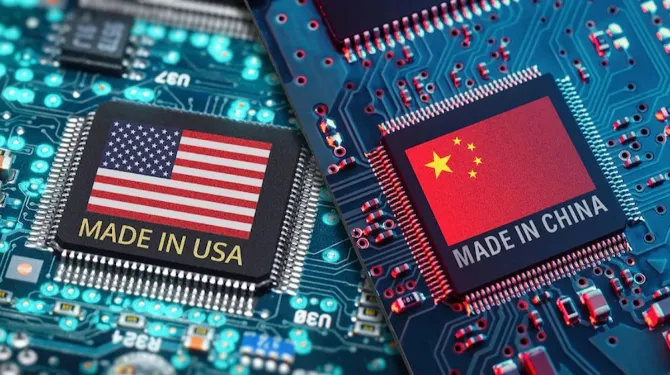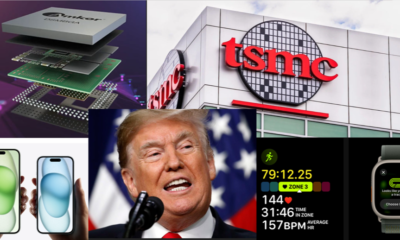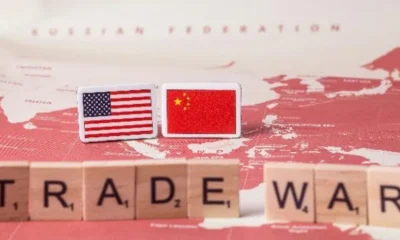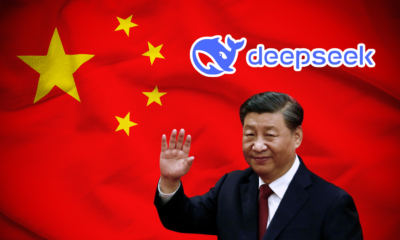Business
SoftBank’s Masayoshi Son Wants To Make India Global Chip Capital. But How Long Is That Road For India?
Published
11 months agoon

India dreams big—its eyes set on becoming the world’s third-largest economy. But Masayoshi Son, the founder of SoftBank, has an even more ambitious vision that of transforming India into the global hub for semiconductor chips.
Son sees India’s potential to evolve from a software services powerhouse into a world-class chip design hub. He believes the country could be the next Silicon Valley, but this time focused on semiconductors, leveraging its vast talent pool.
The Master Plan
Son’s blueprint includes teaming up with British semiconductor giant Arm Holdings to nurture homegrown chip design talent.
The goal? One million chip designers, trained through partnerships with Indian universities and institutions. With SoftBank owning a 90% stake in Arm Holdings, which recently made waves with the biggest IPO of 2023, raising $4.87 billion and hitting a market cap of $140 billion, it could not get better than this.
Betting Big on India—and AI
SoftBank isn’t new to India. Over the past decade, it’s poured $11 billion into Indian startups through its Vision Funds, betting on companies like FirstCry and Ola Electric, both of which delivered successful IPOs this year.
Swiggy, another big name in SoftBank’s portfolio, remains strong, with the company holding onto its 8% stake during its public offering.
In a recent meeting with Indian entrepreneurs, Son encouraged them to think beyond the linear path and embrace AI with a long-term vision. He cited estimates suggesting $9-12 trillion in capital expenditure will flow into AI infrastructure over the next decade. SoftBank is already all in, bankrolling a $100 billion venture to complement Arm Holdings and challenge Nvidia in the semiconductor space.
Beyond semiconductors, SoftBank’s Vision Fund has placed a $500 million bet on OpenAI, with plans to invest another $1.5 billion. In July, SoftBank also acquired UK-based AI chipmaker Graphcore, strengthening its foothold in the AI chip sector.
The ISM Push
India isn’t sitting idle. The government’s Indian Semiconductor Mission (ISM) aims to boost the country’s chip manufacturing, packaging, and design capabilities. In its first phase, Tata Electronics’ $11 billion project to establish a semiconductor fabrication unit in Gujarat got the green light.
Under ISM, companies receive nearly 50% of their capital costs as subsidies, with states offering an additional 15-25%. As of September, the mission is set to receive a $10 billion budget boost for its second phase.
India on Becoming a Semiconductor Powerhouse—But How Long Is the Road?
India has set its sights on becoming a major player in the global semiconductor industry, a key move in its broader push for self-reliance in manufacturing. As the fifth-largest economy, the bets are high, and so are the ambitions.
Prime Minister Narendra Modi has laid out an ambitious roadmap to grow India’s electronics sector from its current $155 billion to a whopping $500 billion by 2030. The announcement grabbed attention and sparked debate. Industry insiders, however, are divided on whether this goal is achievable. The one thing they agree on? India can’t do it alone.

Starting from Scratch
“While the momentum is strong, India is essentially starting from zero in semiconductor manufacturing,” said Eri Ikeda, an assistant professor at IIT Delhi’s Department of Management Studies. Despite the rapid pace of development, India is entering a field dominated by seasoned players.
Currently, Taiwan leads the global semiconductor market with a 44% share, followed by China (28%), South Korea (12%), the U.S. (6%), and Japan (2%), according to data from consultancy Trendforce.
Collaborations. The Key to Success
Industry partnerships are already taking shape. Taiwan’s Powerchip Semiconductor Manufacturing Corporation is teaming up with Tata Electronics to build India’s first 12-inch wafer fab in Gujarat. Meanwhile, U.S.-based Micron Technology is on track to roll out India’s first domestically made semiconductor chip by 2025.
Just last week, Tata Group and U.S. chipmaker Analog Devices signed an agreement to explore building semiconductor products in India—a clear sign that collaboration is crucial.
The Chinese Blueprint
India is being seen more and more as a solid alternative to China for companies looking to diversify their supply chains amid rising geopolitical tensions. But before India can truly compete with the East Asian giant, there are a few lessons to learn—especially in the semiconductor space, where India’s industry is still in its infancy.
China continues to dominate trade with India, reclaiming its spot as India’s top trading partner in 2024. Bilateral trade hit $118.4 billion, with India importing $4.2 billion worth of telecom and smartphone parts from China, according to the Ministry of External Affairs.
“India is far behind China in semiconductor manufacturing. Even if India picks up speed, China will still be running faster,” said Rishi Bhatnagar, chair of the Institution of Engineering and Technology’s future tech panel. He believes collaboration, not competition, is the way forward.
China itself is chasing technological leaders like TSMC by scaling its semiconductor industry, heavily importing equipment from the U.S. and Japan. “If even China is playing catch-up, India’s path will be even steeper,” noted Eri Ikeda, an expert from IIT Delhi.
India’s Strategy is Teaming Up with the U.S.
India may still depend on Taiwan and China for chipmaking expertise, but it’s also deepening ties with the U.S. In September, the U.S. Department of State announced a partnership with India’s Semiconductor Mission and electronics ministry to strengthen the global semiconductor supply chain.
This move came just days before the Biden administration introduced new export controls on advanced technologies, including semiconductors, aimed at slowing down China’s progress in AI and computing.
For the U.S., India presents a strategic opportunity to diversify chip sources and reduce its reliance on Taiwan. “Investing in a democratic country with a legal framework and a growing English-speaking workforce is a safer bet,” Bhatnagar said. He added, “When two democracies are talking, it’s a different kind of conversation—especially in these shifting global dynamics.”
Earlier this week, Prime Minister Modi met with top tech CEOs like Nvidia’s Jensen Huang and Google’s Sundar Pichai during a New York roundtable. Huang declared, “This is India’s moment,” pledging Nvidia’s support. Also present were leaders from GlobalFoundries and AMD, signaling strong interest from major semiconductor players.

India’s Role in the U.S.-China “Chip War”
India’s growing semiconductor focus could also boost the U.S.’s position in its ongoing “chip war” with China. “India is willing to leverage both U.S. and Chinese investments to build its industry, even if that means competing with them later,” said Ikeda.
However, she warned that India faces significant challenges, especially around infrastructure and investment. Commerce Minister Piyush Goyal is optimistic but realistic, saying, “We’re encouraging the semiconductor industry in a big way and building the ecosystem. Foundries will follow once the groundwork is in place.”
India may have a long road ahead to become a semiconductor powerhouse, but it’s not without a few key advantages that could help it stand out.
One of the biggest draws? Low labor costs. Companies looking to diversify their supply chains away from China are already eyeing India. For instance, the minimum monthly wage for skilled workers in New Delhi is around ₹21,215 ($254), whereas in Beijing, it’s about 2,420 yuan ($344). While wages vary across regions, the gap is clear—and it gives India an edge.
“If India can advance technologically and meet global demand with cost-effective, good-quality products, it could outcompete China,” says Eri Ikeda, an expert from IIT Delhi.
A Growing Magnet for Tech Giants
India’s massive population and promising economic future are also major selling points. Goldman Sachs predicts India will become the world’s second-largest economy by 2075. Tech giants like Apple and Google are already increasing their investments.
“Apple is exporting more from India than it sells domestically. That’s a big deal,” notes Tarun Pathak, research director at Counterpoint Research. He adds that India’s vast domestic market and youthful workforce are big pluses.
This optimism is backed by significant infrastructure upgrades. The government plans to increase capital expenditure by 11.1% in 2025 to ₹11.11 trillion ($134 billion), focusing on highways, railways, and airports.
And as Rishi Bhatnagar points out, “The semiconductor industry doesn’t need massive ships. Chips are small and can be flown in large quantities.” This makes India’s expanding transportation network an even bigger asset.
Meeting the Growing Demand for Chips
With global demand for semiconductors only rising, India is positioning itself as a cost-effective solution for companies looking to scale production and lower costs.
“I wouldn’t bet against India,” says Samir Kapadia, CEO of India Index and managing principal at Vogel Group. “Few countries offer the right mix of infrastructure, economic stability, and workforce that India does.”
Still, competition is fierce. Taiwan, South Korea, China, and the U.S. currently dominate the semiconductor market, with Taiwan and South Korea holding the lion’s share of chip foundry capacity. But with India’s growing momentum and its strategic advantages, it’s clear the country is ready to step up and challenge the status quo.
The question isn’t whether India can compete—it’s how soon it will be a major player in the global semiconductor arena.
You may like
-


Taiwan’s ‘Historic’ TSMC Deal, A Win Or The End Of Its ‘Silicon Shield’ As China Threatens? A Jittery Taiwan Watches Trump’s Moves On Ukraine, Wondering, Could We Be Next?
-


A Trade War That Just Won’t Quit. As Trump’s Tariffs Hit, China Stays The Course, For Xi’s Its Business As Usual Strategy
-


Indian Stock Market In Turmoil. Investors In Panic Mode, Is This A Temporary Correction Or The Start Of A Bear Market?
-


America And China’s Thirst For Gold In 2025 Is Draining Other Countries’ Reserves; Here’s Why?
-


Shakeup In The Auto Sector. Mercedes-Benz 15% Job Cuts, Nissan CEO Exit, And Germany’s Make-Or-Break Year
-


DeepSeek Ai Rush. China’s AI Contender Gears Up for Next Big Launch Even As It Gets Xi Jinping’s Blessings
